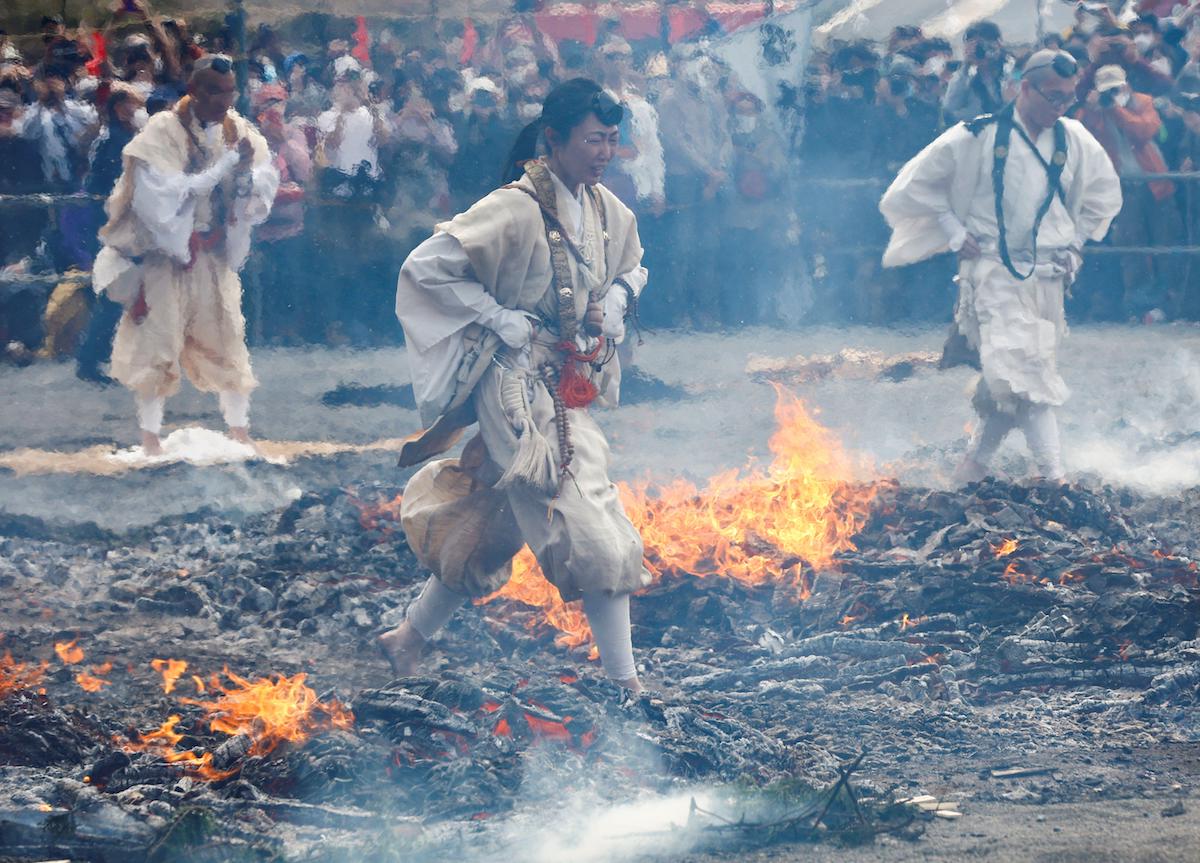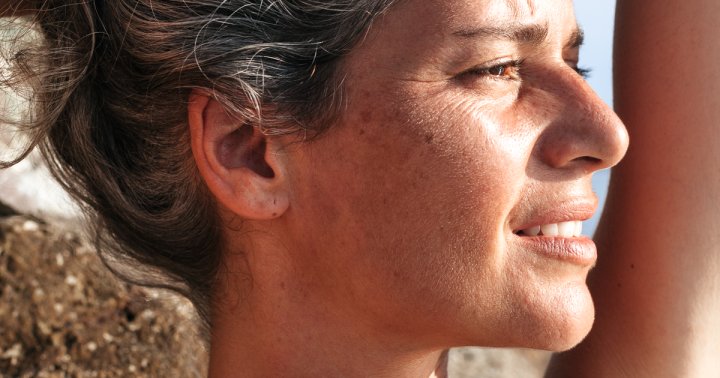Read “Masculinities Beyond the Buddha,” an Excerpt from Buddhist Masculinties
An excerpt of Buddhist Masculinities edited by Megan Bryson and Kevin Buckelew— as reviewed in the Fall 2023 issue of Buddhadharma: The Practitioner’s Guide The post Read “Masculinities Beyond the Buddha,” an Excerpt from Buddhist Masculinties appeared first on...

This excerpt of Buddhist Masculinities edited by Megan Bryson and Kevin Buckelew— as reviewed in the Fall 2023 issue of Buddhadharma: The Practitioner’s Guide — is provided courtesy of the publisher, Columbia University Press. We thank Columbia University Press for sharing this with Buddhadharma‘s readers, and we thank our readers for supporting dharma publishers.
WOMEN FOUND THE Buddha irresistible: they lusted after his perfect body and concocted all kinds of schemes to get close to him. In the palace, “some of the young women pretended to be intoxicated and touched [Prince Siddhārtha] with their firm, rounded, close-set, alluring breasts. One made a false stumble and clasped him strongly with her tender arm-creepers, which hung down loosely from her drooping shoulders.” While the Buddha’s physical beauty drew admirers, his appeal went beyond conventional good looks. Buddhas’ bodies differ from those of ordinary people: they display the thirty-two marks of a “great man” (Sk. mahāpuruṣa), which include a long, broad tongue; a tuft of hair between the eyebrows; webbed hands and feet; and a sheathed penis, like that of a horse or elephant, which defines Buddha bodies as both masculine and exceptional. Buddhist monarchs (Sk. cakravartins, or “wheel-turners”) also sport these thirty-two marks, offering a masculine counterpart to buddhas. According to his hagiography, the Buddha’s fate was to become either a great religious leader or a great ruler, and these twin possibilities hint at the contours of hegemonic Buddhist masculinities. It is, in fact, the Buddha’s simultaneous embodiment of religious and political perfection that makes him such a superman.
Understandably, the Buddha’s masculine example holds considerable sway in the religion he founded. However, as people continuously inscribed, portrayed, and enacted his teachings, they developed other models and concepts of Buddhist masculinity. This volume explores the variety of
masculinities in Buddhism across place and time, from early India to medieval China to modern Europe, considering rulership in Sri Lanka and Tibet, machismo in Japan and Europe, and laymen in Burma and Thailand. The Buddha still looms large as the Buddhist man par excellence, but he is joined by other masculine figures and ideals that make up the Buddhist world, such as Tibet’s demon-tamer Padmasambhava, the bodhisattva-kings of medieval Sri Lanka, and macho Zen practitioners in twentieth-century Japan.
Exploring Buddhist masculinities over a wide historical and geographical range reveals the diversities in Buddhist conceptions of masculinity as well as highlights recurring concerns: How should Buddhist rulers behave as paragons of lay masculinity? How should monks deal with their own and others’ sexual desires? How should people adapt Buddhist norms for masculinity to new regions, which have their own norms? How should Buddhists respond to gendered behaviors that diverge from perceived canonical or cultural norms for men? Each of these questions centers on norms for men’s behavior, even if those norms differ according to context. As such, this volume as a whole considers how Buddhists in different times and places have engaged with hegemonic masculinities.
Adopting Antonio Gramsci’s notion of hegemony, Raewyn Connell defines hegemonic masculinity as “the configuration of gender practice which embodies the currently accepted answer to the problem of the legitimacy of patriarchy, which guarantees (or is taken to guarantee) the dominant position of men and the subordination of women.” As a configuration of gen- der practice, hegemonic masculinity does not just mean one kind of ideal man or male role: in the United States in the twenty-first-century, professional athletes may embody hegemonic masculinity, and so can CEOs, manual laborers, and certain actors, together forming a matrix of masculinity that undergirds the patriarchy’s legitimacy. As a key part of patriarchal power, hegemonic masculinity not only perpetuates men’s domination of women, nonbinary, and third gender people but also subordinates other masculinities, and the people who embody those subordinated masculinities.
Specific forms of hegemonic and subordinated masculinities are historical. As Tim Carrigan, Raewyn Connell, and John Lee explain, “ ‘Hegemony,’ then, always refers to a historical situation, a set of circumstances in which power is won and held. The construction of hegemony is not a matter of pushing and pulling between ready-formed groupings, but is partly a matter of the formation of those groupings. To understand the different kinds of masculinity demands, above all, an examination of the practices in which hegemony is constituted and contested—in short, the political techniques of the patriarchal social order.” In the Buddhist contexts under consideration here, we encounter both hegemonic masculinity in the figures of virile bodhisattvas, Buddhist rulers, and macho monks, as well as subordinated masculinities in the form of figures like the effeminate monk Xuanzang (a.k.a. Trepiṭaka) from the East Asian epic Journey to the West (Ch. Xiyou ji; Saiyūki).
Hegemonic masculinity necessarily encompasses contradictory conceptions of what it means to be an ideal man, similar to the virgin-whore dichotomy for women in the modern West. For example, an ideal man might show self-control in abstaining from sexual activity, or he might show virility (and possibly control over others) in having many sexual partners. These apparent contradictions in what it means to be a “real man” also manifest in Buddhist discourses and practices, where the Buddha stands out as encompassing the paradox of hegemonic masculinity: he is a virile ascetic, a martial meditator, and a royal monk detached from his own remarkable beauty. Connell’s term uses the singular masculinity to underscore the patriarchal system in which masculinity holds sway over femininity. The different Buddhist contexts under consideration here entail plural hegemonic masculinities. Despite their differences, these Buddhist contexts could generally be understood as patriarchal, but patriarchy is not only about men’s domination of women; it also concerns senior generations’ domination of their juniors. Moreover, the configuration of gender practices that are central to hegemonic masculinity operate together with other historically contingent categories of difference, including race or ethnicity, social class, age, and ability. Any informed study of Buddhism and gender, including Buddhist masculinities, must take into account how gender norms intersect with these other kinds of norms. For example, in the contemporary globalized world, hegemonic masculinity works together with hegemonic whiteness to legitimate and naturalize white supremacist patriarchy. This means that images of Buddhist men in the modern West often traffic in Orientalist stereotypes of wise, peaceful sages or kung-fu monks, or cast Buddhist men as effeminate.
Though not all of these categories of difference translate to the various regions and time periods covered in this volume, many do: although
Buddhist kingship engages hegemonic masculinity, it also connects directly with political power and socioeconomic status. Similarly, representations of the monk Xuanzang in contemporary East Asian retellings of Journey to the West engage concepts of queer identity and gender fluidity. Focusing on gen- der alone, without attending to other categories of difference, risks conflating the masculinities embodied by medieval Sri Lankan bodhisattva kings and the queer and genderfluid masculinities represented through the figure of Xuanzang in contemporary East Asia.
One of this volume’s foundational claims is that the concept of masculinities helps us make sense of Buddhist thought, practice, and embodiment in different times and places. This does not mean, however, that we see masculinity as an ahistorical, unchanging concept, or even a concept that our sources would use to describe their own practices. As Connell notes, the concept of masculinity “presupposes a belief in individual difference and personal agency. In that sense it is built on the conception of individuality that developed in early-modern Europe with the growth of colonial empires and capitalist economic relations.” Like the terms sexuality and gender, masculinity emerges from a particular historical moment and belongs to notions of selfhood that support, and are supported by, imperialism and capitalism. By the early twenty-first century, masculinity had become part of the increasingly fractured and cataloged selfhood engendered through the rise of transnational corporations and personal brands. It is in this context that we find masculinities that can be modified by categories of race, sexuality, gender identity, ability, class, and religion.
Foregrounding masculinities may in some respects naturalize and rein- force this late capitalist web of power, encompassing the imbricated realms of religion, politics, economics, and personhood. This applies equally to other concepts undergirding this project, such as Buddhism, gender, and religion. We continue to use (and translate) this vocabulary to participate in ongoing conversations about these topics and to create new conversations. For example, Jarrod Whitaker’s study of Vedic masculinities connects the Sanskrit terms śūra and vīrá (among others) to the concept of masculinity, because both describe standards for men’s behavior. Whitaker criticizes the common translation of vīrá as “hero” because of the confusion with Greek heroism and contemporary hero inflation (e.g., ubiquitous superheroes), preferring “brave man” instead. However, some terms defy translation because their many meanings overwhelm any single English term. For example, Indian Buddhist texts use the Sanskrit term paṇḍaka to indicate people with nonnormative bodies, sexual proclivities, or sexual capacities, which can include ambiguous genitalia, voyeurism, or impotence. Bee Scherer has compellingly argued that the term paṇḍaka should remain untranslated—or, if necessary, be rendered as “gender-deficient”—because translations such as “queer” or “sexual deviant” introduce anachronism and flatten the Sanskrit term’s polyvalence. Such conversations can also occur around the Chinese term da zhangfu (great man), whose meaning was reshaped by Buddhist scriptures in Chinese translation that used it to render the Sanskrit mahāpuruṣa, which Kevin Buckelew examines in his chapter. By acknowledging multiple Buddhist masculinities and multiple ways of translating these masculinities, we resist the notion that Buddhists throughout history have identified only one way to be an ideal man or to embody traits associated with men or male beings.
Of course, defining masculinities as qualities associated with men risks devolving into recursion, if men are defined as men by virtue of their masculinity. Attempts to define masculinity or male identity through specific social roles or notions of biological sex will also fail due to the vast temporal and geographical range under consideration here. One virtue of our broad coverage is that there is no universal consensus on a singular kind of masculine body or identity. Our sources generally ascribe to human men or anthropomorphic masculine beings (implicitly or explicitly) a body with a penis and testicles, a relatively flat chest, and, possibly, facial hair, but Buddhist texts also describe exceptional bodies lacking any genitalia, fluid bodies capable of manifesting different kinds and combinations of primary or secondary sex characteristics, or bodies with ambiguous or otherwise non-normative genitalia. For example, the Nara-period (710–784) Japanese nun Sari was said to lack a vagina, and this physical distinction was tied to her Buddhist prowess.
Scholars such as Thomas Laqueur, Michel Foucault, and Judith Butler have shown how different historical and cultural contexts give rise to different understandings of, and categories for, norms surrounding bodies and genders. For example, in South Asia the Brahmanical Laws of Nārada (Sk. Nāradasmṛti) describes the ideal man as follows: “His vertebrae, knees, bones, shoulders, and neck should be well built. The nape of his neck should be tough, as should his torso, thighs, and skin. He should have a smooth gait and voice. His feces should sink in water, his urine should be noisy and foamy. If he has these characteristics he is virile; if not, he is [a paṇḍaka].” Later Chinese medical thought defined male bodies as those capable of penetrating others, and female bodies as those capable of being penetrated. Contemporary biomedical discourse defines sex based on chromosomes as well as primary and secondary sex characteristics, which then renders “unnatural” gender identities and sexual orientations that do not conform to these biological features. These examples show that understandings of what make people male, female, both, or neither, and related understandings of how people might diverge from those norms, vary according to context. In arguing for the relevance of masculinities across a wide temporal span and geographical range, this volume does not take for granted that there is an obviously male or masculine body or identity that transcends time and place. Furthermore, in juxtaposing our sources’ many sex/gender binaries (some of which mark the two ends of a spectrum rather than marking only two possibilities), this volume creates a sex/gender matrix that undermines any single binary.
The first word in Buddhist masculinities also requires reflection: What exactly makes these masculinities Buddhist? As José Cabezón and John Powers have shown, early Indian Buddhism belonged to a broader context with hegemonic masculinities that crossed religious boundaries, such that even unambiguously Buddhist figures like buddhas, bodhisattvas, and arhats show continuities with Vedic and Brahmanical masculinities. Later, as monks and merchants took Buddhism to other parts of Asia, people from Thailand to Tibet to Tokyo brought the religion into conversation with existing traditions, which involved adapting to new understandings of masculinity. As Marcus Evans demonstrates in his chapter, RZA, the “Abbot” of hip-hop’s Wu-Tang Clan, draws on Chan ( J. Zen) Buddhism to foreground Afro-Asian brotherhood and challenge the hegemony of white American masculinities in his The Man with the Iron Fists films. Buddhist masculinities thus include those forms of masculinity with strong connections to Buddhism, but that might not be solely or uniquely Buddhist. We adopt a broad, flexible understanding of Buddhism that allows for the forms of masculinity under consideration here to simultaneously belong to other religions. If it were grammatically possible, this volume’s title would highlight the multiplicity of Buddhisms in addition to multiple masculinities.
It is an understatement to say that Buddhist men have already received considerable scholarly attention, but the study of Buddhist men is not the same as the study of Buddhist masculinities. The difference is that scholarship on Buddhist men rarely addresses gender as an object of analysis, allowing masculinity to go unnoticed and unmarked, which perpetuates its normative status. Only when the masculinity in question diverges from the normative does it become marked, as in male same-sex encounters or relationships, or in gender identities such as paṇḍaka or chigo. This volume does address non- normative masculinities, but focuses on normative or hegemonic masculinities. In calling attention to how Buddhists have developed various forms of masculinity in different historical and geographical contexts, our goal is to reveal how masculinities are constructed and contingent, rather than natural and inevitable.
When gender is an object of investigation in Buddhist studies, it is usually women and femininity that take center stage. Such projects do valuable work in redressing our sources’ disproportionate attention to men, an imbalance that modern scholarship reproduces. However, if the phrase Buddhism and gender only conjures images of nuns, exceptional female rulers, lay- women, and goddesses, we reproduce the imbalance in which only femininity is marked, and masculinity (at least its hegemonic versions) gets to be normal. Studies of Buddhist women usually treat gender as a key facet of their experience, but studies of Buddhist men rarely do the same. By fore- grounding hegemonic Buddhist masculinities, this volume demonstrates how scholars can recognize and analyze masculinity even—or especially— when it is unmarked in our sources, thus opening up additional possibilities for understanding Buddhism and gender. Expanding the scope of Buddhism and gender involves not only incorporating studies of men and masculinity but also allowing for feminine men, masculine women, and those who defy binary categorization. Nuns, female rulers, and goddesses like Marīcī combine masculine and feminine qualities in ways that go unnoticed if we limit our inquiries to masculine men and feminine women.
While the study of Buddhism benefits from incorporating questions of masculinity, Buddhism contributes to the study of masculinities as well. First, studying Buddhist masculinities in different places and times high- lights several counterexamples to Orientalist stereotypes of Buddhist men and offers a more thorough and nuanced account of hegemonic and subordinated masculinities across the Buddhist world. Second, as Cabezón notes, Buddhists have had their own theories of gender, including masculinity, that both underscore the contextually contingent nature of contemporary gen- der discourse and offer a repertoire of concepts for rethinking gender in our own places and times. Finally, Buddhism’s global spread allows us to better consider how religion and gender interrelate: by observing which questions persist in different forms of Buddhism, we gain a clearer view of what makes particular forms of masculinity “Buddhist,” and we better understand the process of mutual transformation as people bring Buddhist teachings and practices to new regions.
Excerpted from Buddhist Masculinities edited by Megan Bryson and Kevin Buckelew. Copyright (c) 2023 Columbia University Press. Used by arrangement with the Publisher. All rights reserved.

 Astrong
Astrong 
































